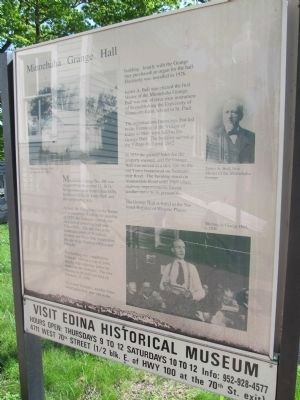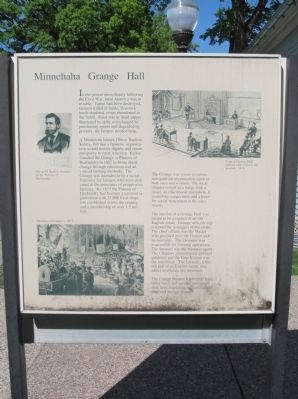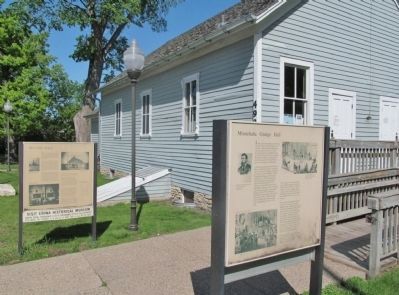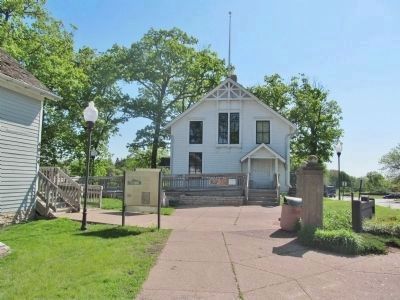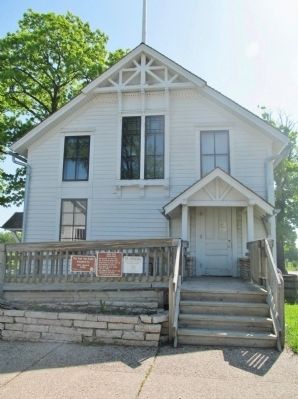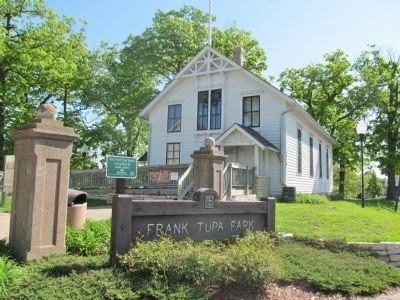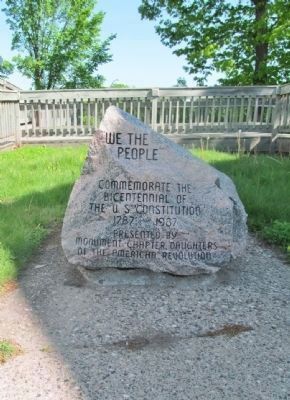Golf Terrace Heights in Edina in Hennepin County, Minnesota — The American Midwest (Upper Plains)
Minnehaha Grange Hall
[west side]
Minnehaha Grange No. 398 was organized on December 12, 1873. Its members came from Edina Mills, Richfield Mills, St. Louis Park and the surrounding area.
At first, the Grange met in the homes of its members. Then in the summer of 1879, the Grangers started construction of a meeting hall near Edina Mills. The site was at the southeast corner of Wooddale Avenue and West 50th Street (now the site of St. Stephen's Episcopal Church).
The building was completed in February 1880 at a cost of $400, largely with volunteer labor furnished by the Grangers. The first meeting in the hall was held on February 27, 1880.
The Good Templars, another fraternal organization, also met in the building. Jointly with the Grange they purchased an organ for the hall. Electricity was installed in 1926.
James A. Bull was elected the first Master of the Minnehaha Grange. Bull was one of three men instrumental in establishing the University of Minnesota Farm School in St. Paul.
The organizational meetings that led to the founding of the Village of Edina in 1888 were held in the Grange Hall. The building served as the Village Hall until 1942.
In 1935 the ground lease for the property expired, and the Grange Hall was moved to a new site on the old Yancy homestead on Normandale Road. The building stood on Normandale Road until 1969 when highway improvements forced another move to its present site.
The Grange Hall is listed in the National Register of Historic Places.
[east side]
In the period immediately following the Civil War, rural America was in trouble. Farms had been destroyed, farmers killed in battle, livestock herds depleted, crops abandoned in the fields. Food was in short supply. Burdened by debt, overcharged by purchasing agents and degraded by poverty, the farmers needed help.
A Minnesota farmer, Oliver Hudson Kelley, felt that a farmers' organization would restore dignity and return prosperity to rural America. Kelly founded the Grange or Patrons of Husbandry in 1867 to bring about change through education and advanced farming methods. The Grange was intended to be a social fraternity for farmers who were dedicated to the principles of progressive farming. By 1875 the Patrons of Husbandry had become a national organization with 21,000 local chapters established across the country and a membership of over 1.5 million.
The Grange was a non-sectarian, non-partisan organization open to both men and women. The local chapter served as a lodge with a ritual, an educational institution, a marketing cooperative and a force for social betterment in the community.
The interior of a Grange Hall was meant to be a replica of an old English estate. Grange officials represented the managers of the estate. The chief officer was the Master who presided over the Grange and its meetings. The Overseer was responsible for farming operations. The Steward was the business agent. The Chaplain administered spiritual guidance and the Gate Keeper was the watchman. The Lecturer, while not part of an English estate, was added to educate the members.
The Grange became a powerful legislative force and secured passage of state laws regulating railroad freight rates and storage charges.
Topics. This historical marker is listed in these topic lists: Agriculture • Fraternal or Sororal Organizations. A significant historical month for this entry is February 1880.
Location. 44° 54.643′ N, 93° 20.979′ W. Marker is in Edina, Minnesota, in Hennepin County. It is in Golf Terrace Heights. Marker is on Eden Avenue west of Grange Road, on the right when traveling west. Marker is at Frank Tupa Park. Touch for map. Marker is at or near this postal address: 4918 Eden Avenue, Minneapolis MN 55424, United States of America. Touch for directions.
Other nearby markers. At least 8 other markers are within 3 miles of this marker, measured as the crow flies. Old Cahill School (here, next to this marker); Edina Mills (approx. 0.4 miles away); Edina Mill: A Fast Creek Generates Industry... and a Community (approx. 0.4 miles away);
Dwight Williams Park (approx. 0.4 miles away); A Creek, a Cause and Some Cows: Add Together, What Do You Get? (approx. 0.4 miles away); Edina Veterans Memorial (approx. half a mile away); In 1939, this was more than just a park. (approx. 2.2 miles away); Como–Harriet Streetcar Line (approx. 2.3 miles away). Touch for a list and map of all markers in Edina.
More about this marker.
[photo captions, clockwise, west side]
• Minnehaha Grange Hall on original site, 1925
• James A. Bull, first Master of the Minnehaha Grange
• Meeting in Grange Hall, c. 1920
[photo captions, clockwise, east side]
• Oliver H. Kelley, founder of the Patrons of Husbandry
• Typical Grange Hall interior with officers in position, 1874
• Meeting of Grangers, 1873
Credits. This page was last revised on February 12, 2023. It was originally submitted on May 18, 2012, by Keith L of Wisconsin Rapids, Wisconsin. This page has been viewed 771 times since then and 13 times this year. Photos: 1, 2. submitted on May 18, 2012, by Keith L of Wisconsin Rapids, Wisconsin. 3. submitted on May 30, 2012, by Keith L of Wisconsin Rapids, Wisconsin. 4, 5, 6, 7. submitted on May 18, 2012, by Keith L of Wisconsin Rapids, Wisconsin.
